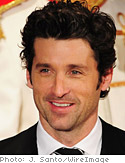Patrick Dempsey's Aha! Moment

He left the town he grew up in to search for something meaningful to do with his life…which led the star of Grey's Anatomy right back to where he started.
I was 17 when I left the small Maine town where I'd grown up. I wanted to do something I thought was important with my life, so I headed to California and didn't look back.In Los Angeles, as I gained and lost celebrity, then gained it again, I often found myself wondering why I, out of thousands like me, had become famous. Fame is a delicate and dangerous creature; I saw people who didn't honor it, who refused to take responsibility for it, get destroyed by it. I also saw that stardom in and of itself was empty. What was the purpose of it all?
In 1998, my then-girlfriend (and now-wife), Jillian Fink, and I went back east to see my mother. During the trip, my mom seemed weaker than usual. This was a woman who had raised us on a farm and rode horses almost every day; I had never seen her vulnerable before. When I got back to L.A., my mother called. The test results were in—she had ovarian cancer.
Suddenly, I wanted more than anything to be back home with her. I wanted out of Hollywood's smog and concrete; disconnected from the nature I'd grown up with—the rocky beaches, the land—I had become numb. Jillian and I bought our own farm, and to keep her mind off her diagnosis, my mother helped us fix it up. My job was still in L.A., but whenever I could, I went back to my farm to feel the changes in seasons, the strong weather, the salty coastal air. As we mowed the tall grass and planted trees, my mother battled through treatment and went into remission.
After my mother's diagnosis, I began to work with Breakaway from Cancer, a national organization that supports people living with the disease. As I became more involved in the charity, and as my TV show took off, I started to see that I might be able to do even more to give back. And if I was going to reach out, I wanted to reach out to my hometown.
This past Christmas Eve, nearly 10 years after my mother's diagnosis, I toured Central Maine Medical Center in Lewiston, Maine, where the Patrick Dempsey Center for Cancer Hope and Healing would soon be opening. My sister Mary and I got funding, sent e-mails, made phone calls, conceptualized the entire thing, and finally it was becoming a reality. Along the way, Mary and I rediscovered our relationship, and I had new respect for her professionalism and previously hidden writing talent. I sat in the boardroom and spoke about our plans: an educational website (dempseycenter.org); a place people could come to, to talk about their illness; an antismoking campaign. Once the center was running, we wanted to take it national, even global, to help as many people as possible.
While we were talking, a chef served us clam chowder, that classic New England dish. I looked down at the soup and the little bag of oyster crackers, and I realized that I, the person who had taken off as soon as I could, was back and involved in something that was the most important thing I'd ever done, other than being a good father to my children. I left Maine to search for my purpose. After a long journey, I came home again, and it was here that I found what I was looking for.
— As told to Justine van der Leun



